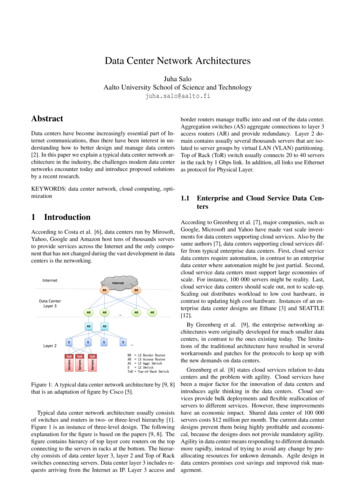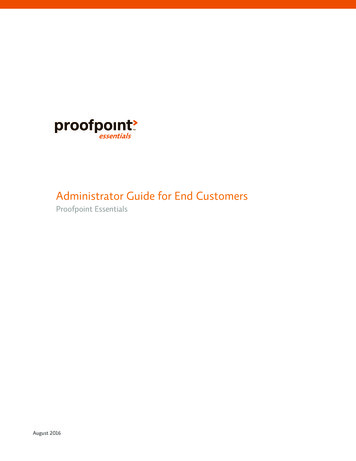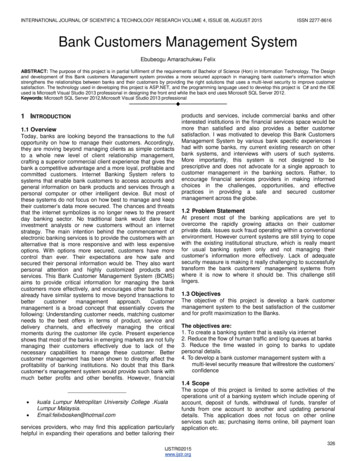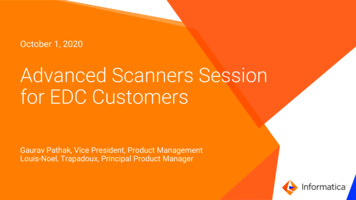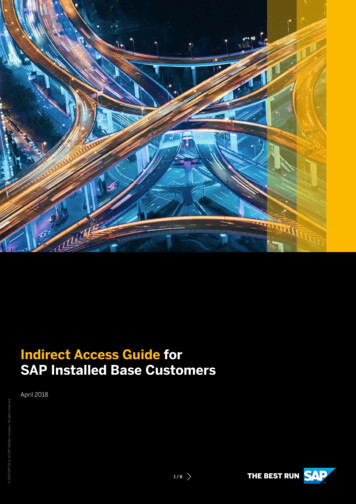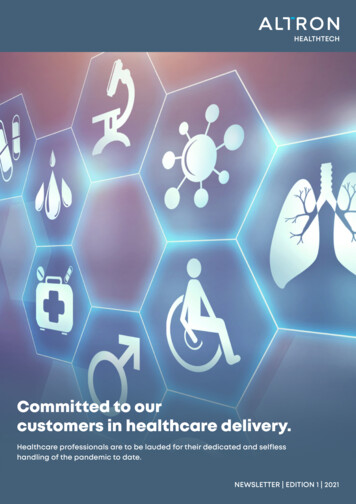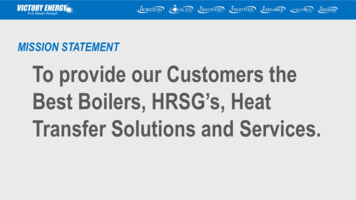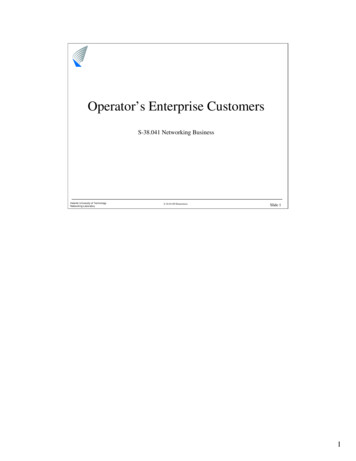
Transcription
Operator’s Enterprise CustomersS-38.041 Networking BusinessHelsinki University of TechnologyNetworking LaboratoryS-38.041/H HämmäinenSlide 11
Enterprise IT in Nutshell The average enterprise spends––––c. 4% of its gross revenue on ITc. 500 EUR per month per employee on ITc. 5-7% of total headcount on IT headcountc. 60 EUR per employee per month on mobile (operator ARPU) Highest spending per employee in IT, telecom and financialsectors Global enterprise IT market– c. 1000 BEUR in 2003– largest part is system integration and outsourcing services– c. 50% of global IT spending happened in the US in 2003Helsinki University of TechnologyNetworking LaboratoryS-38.041/H HämmäinenSlide 22
Enterprise view of IT tSymbolNCRNokiaKey categoryvendorsHelsinki University of TechnologyNetworking LaboratoryS-38.041/H HämmäinenSlide 33
Key Issue AnalysisTCO is a powerful tool that is used to identify opportunities for better managing theIT environment. Some analysis, such as that needed to make an outsourcingdecision, is impossible without understanding internal cost structures — includinghidden costs. Enterprises that fail to account for all costs will also fail to see IT costsincrease beyond sustainable and justifiable levels, and will make poor ITmanagement decisions.Total cost of ownership rkSoftwareOperating eciationLeasingExpensesUpgrades andSuppliesHelsinki University of TechnologyNetworking etworkSystemStorageSupportExecutive andadministrationHelp sinessapplicationsCommunicationWANService providerRASInternet accessproviderClient accessManagement &SupportOutsourcingMaintenancecontractsSupport contractsService levelsPerformance andService levelMetricsS-38.041/H HämmäinenEnd User ISPeer/self supportCasual learningScripting/developmentEnd-user TrainingSatisfactionDowntimePlannedUnplannedSlide 4Key Issue: How is TCO used most effectively today?Why measure TCO?To obtain a better understanding of how IT investments support – or do not support enterprise business goalsand processesTo gain objective information on costs and savings opportunities in “right-sizing,” outsourcing and internalresource allocationTo identify and implement strategies for improving IS operations and performanceTo gain comparative, competitive data against industry indices, best in class or peer enterprisesTo understand key metrics and measurements needed to better run IS operations and provide value back to theenterprise4
Strategic Planning Assumption: Through 2007, full support for PDAs’ mobile phones will raiseenterprise total cost of ownership (TCO) for client devices by at least 30 percent per user per year(0.7 probability).Total cost per mobile employeeCase: 100 terminals for 3 yearsLaptopPDACellphoneAcquisition 2200 600 200TCO per year 12300 1946 1414Investment life3-4 years24 months18 monthsReplacements-OnceOnceTotal(2200 3x12300)x100 3900K(2x600 3x1946)x100 704K(2x200 3x1414)x100 464KSource: Gartner, 2003Helsinki University of TechnologyNetworking LaboratoryS-38.041/H HämmäinenSlide 5How will mobile, wireless management evolve?As individuals carry more and more mobile devices — now up to several phones and PDAs in addition to alaptop or notebook — the cost per individual to the enterprise for safeguarding and managing platforms anddata will rise. As illustrated above, Gartner provides the analysis for assessing and managing such costs.Gartner’s analysis of TCO for PDAs or smart phones with personal information manager (PIM) features isbased on a review of the Windows and Palm platforms. Capital costs are based on a device with an acquisitioncost as low as 150, but growing to 600 or more after accounting for accessories, travel kits, initial assetmanagement and user setup. Provision is included for lost devices. Administration costs are considered equalfor both platforms. Technical-support costs are slightly higher for Windows devices due to more-complex userinterfaces. End-user operation costs represent about 40 percent of all costs, primarily due to the time investmentrequired to keep PDAs synchronized with user desktops or servers.Even at a few minutes per day (five minutes was factored into the estimate), this activity is a new diversion ofuser time that costs enterprises more than they might think.Action Item: Enterprises should use TCO models to establish realistic expectations for support costs.5
Enterprise service usage nnectivityPersonal information mgtElectronic mailMessagingVoiceNumber of employees using the serviceHelsinki University of TechnologyNetworking LaboratoryPerson-to-PersonS-38.041/H HämmäinenSlide 6Employees need a multitude of services – but not everyone needs all services Nokia takes a holistic approach to enterprise Rather than horizontal RIM – email MSFT – PIM SAP – business processes We know we are not the only one looking at this holistically, but our strength in enabling applicat Understanding the entire ecosystem here is the key Email is hot item now, but will likely become a commodity like mobile voice is today, but mobilityBusiness processesOffice applications and company specific vertical applicationsBusiness connectivityAccess to intranet from PC/laptop/ terminalPIMCalendar, phonebook, contactse-maile-mail to PC or mobileMessagingVoice, SMS, MMS, instant messagingVoiceCalls in office and on the move6
Role of Telecom Manager Telecom services belong to the strategic toolbox of all enterprises Telecom Manager is the person responsible for defining andimplementing the telecom services strategy of a company Telecom services strategy is closely related to the overall IT strategy Telecom Manager can be a part-time job of a CEO or a full-time job asa leader of telecom expertsTypical mission statementLeverage telecommunications technology and servicesto the greatest possible benefit and competitive advantage of the business– at the lowest costHelsinki University of TechnologyNetworking LaboratoryS-38.041/H HämmäinenSlide 77
Tasks of Telecom Manager Trouble resolution (measurable meters)––– Trouble ticket systemHelp desk systemTraining and end-user educationProject management (measurable meters)–– Triggers for change: innovation, system life cycle, growth, financial reasonsIdentify needs, solicit proposals, select vendors, supervise implementationBilling audit and review (measurable meters)––– Inventory all company telecom services and equipmentExercise audit approval of all telecom billsIdentify and target fraud abusersStrategic planning–––Help to see how telecom aids the company strategyConsolidate an centralize services, equipment, and billing wherever possibleRemain forward-looking into possibly useful new technologyHelsinki University of TechnologyNetworking LaboratoryS-38.041/H HämmäinenSlide 88
Telecom purchase process1.2.3.Define your need (must have/nice to have)Request for proposal/quotation (RFP, RFQ)Select a provider (optimize the price-quality ratio) 4.Manage change successfully Helsinki University of TechnologyNetworking LaboratoryProspecting (pick up max 5-10 candidates for brief interview)Qualification (pick up the top 3-4 for solution presentation)Presentation (pick up 2 for finals, visit reference customers)Closing (check terms and conditions, with your lawyer )Do your partKeep the timelineBe serious about trainingKnow when to cry wolfTell your customersS-38.041/H HämmäinenSlide 99
Typical RFP content Helsinki University of TechnologyNetworking LaboratoryExisting environmentApplications (service level agreements/SLA)Cost expectationsFormat guidelines of responseContact rulesTime framesS-38.041/H HämmäinenSlide 1010
Portfolio of servicesBusiness telephone system Office voice switching (PBX vs Centrex, packet vs circuit)Office voice access (wireline vs wireless)Long-distance callsValue-added services (voice mail, call centers, )PC connectivity Internet access (fiber, ADSL)Intranet (leased lines managed VPN)Value-added services (mailboxes, web hosting, )Mobile wireless services Helsinki University of TechnologyNetworking LaboratoryCellular (GSM, WCDMA)Professional mobile radio (TETRA, iDEN)Two-way radio/walkie-talkiesS-38.041/H HämmäinenSlide 1111
Portfolio of service providersLocal fixed network operator––Main asset: wireline network, subscriber baseTrend: joining forces with other playersNational cellular network operator––Main asset: national cellular coverage, subscriber baseTrend: expanding to full-service, and MVNOService operator––Main asset: server bank, customer serviceTrend: packaging mobile and fixed services, VoIPSystem integrator––Helsinki University of TechnologyNetworking LaboratoryMain asset: tailored software, project modeTrend: exploiting the VoIP and MVNO opportunitiesS-38.041/H HämmäinenSlide 1212
Operator’s Customer SegmentsNumber of employees––Small Price list process (cmp. consumer customers)Large RFP processLocation––Multisite VPN issues (voice, Intranet)International Multioperator issuesOwnership––Private Demand-driven flexible purchase processGovernment Budget-driven regulated purchase processBusiness and service duration––Continuous Customer retention focusEvent (e.g. sports, conferences) General marketing focusSpecific business domainsHelsinki University of TechnologyNetworking LaboratoryS-38.041/H HämmäinenSlide 1313
Impact of Value Nets ICT moves companies from value chains to value nets More dynamic partnerships Companies increasingly outsource, share, and off-shoreICT solutions Extranets– From dedicated networks to Internet– Centralized directory and brokerage servers Voice-over-IP– Trading of outsourced VoIP-PABX capacity– Integration of business rules with VoIPHelsinki University of TechnologyNetworking LaboratoryS-38.041/H HämmäinenSlide 1414
Managing market uncertainty Assess market uncertainty Choose your risk level Experiment with parallel projects– Cut downside, “put eggs in different baskets”– Add upside, “buy several lottery tickets” Keep learning– Use incremental decision milestones for projects– Recalculate business cases of projectsSource:M.Gaynor, 2003Helsinki University of TechnologyNetworking LaboratoryS-38.041/H HämmäinenSlide 1515
Market uncertaintyHow to measure it? Helsinki University of TechnologyNetworking LaboratoryAbility to forecast the marketEmergence of a dominant designAgreement among industry expertsFeature convergence and commodity natureChanges in standards activityS-38.041/H HämmäinenSlide 1616
Choice of management structureCase: email serviceOutsourceYesNoOutsourcedWeb Efficient Low market uncertaintyHelsinki University of TechnologyNetworking LaboratoryCentralserverISPIMAPCentralizedMail -38.041/H HämmäinenDistributed Flexible High market uncertaintySlide 1717
Choice of management structureCase: office voice edPBXsVoIPGSMCentralized Efficient Low market uncertaintyHelsinki University of TechnologyNetworking LaboratoryManagementarchitectureS-38.041/H HämmäinenDistributed Flexible High market uncertaintySlide 1818
Choice of management structureCase: informational service (web)OutsourceYesNoOutsourcedweb-serverService providermanages contentCentralizedUsermanages content Efficient Low market uncertaintyHelsinki University of TechnologyNetworking ementarchitectureS-38.041/H HämmäinenDistributedserversDistributed Flexible High market uncertaintySlide 1919
Value of experimentationReal options theoryValue of experimentation1. increases as the market uncertainty increases2. increases (in a decreasing manner) as the numberof parallel experiments increases3. decreases (in a decreasing manner) as the learningdevelops over generations of experimentsHelsinki University of TechnologyNetworking LaboratoryS-38.041/H HämmäinenSlide 2020
Value of experimentationExamples InternetGPRS contentNTT DoCoMo i-mode contentMicrosoft Windows applicationsSymbian OS applicationsEcosystems that exploit the value ofexperimentation are more likely to match the market needsHelsinki University of TechnologyNetworking LaboratoryS-38.041/H HämmäinenSlide 2121
Case: Finnish UniversitiesTelephony service costPolytechnic schools6Average peremployee ( /y)472#Deviation ( )149Universities8250104 1000 employees8447138 1000 employees621077How to reduce cost? Going GSM-only Going VoIP-onlySource: J. Viskari, 2004Helsinki University of TechnologyNetworking LaboratoryS-38.041/H HämmäinenSlide 2222
Case: Finnish UniversitiesTelephone service cost23,3 %40,0 %internal calls0,9 %Highest volumelocal callslong distance calls8,1 %international callscalls to mobiles27,7 %9,5 %10,1 %Local calls6,5 %Highest costLong-distance callsInternational callsCalls to mobiles73,9 %Source: J Viskari, 2004Helsinki University of TechnologyNetworking LaboratoryS-38.041/H HämmäinenSlide 2323
Case: Finnish UniversitiesReference case: Traffic costs of ”pure tions 17% of calls to other universities (no long-distance charge) 40% of mobile calls internal (based on study)Source: J Viskari, 2004Helsinki University of TechnologyNetworking LaboratoryS-38.041/H HämmäinenSlide 2424
Case: Finnish UniversitiesReference case: Traffic costs of ”Pure GSM”10000
Office voice switching (PBX vs Centrex, packet vs circuit) Office voice access (wireline vs wireless) Long-distance calls Value-added services (voice mail, call centers, ) PC connectivity Internet access (fiber, ADSL) Intranet (leased lines managed VPN) Value-added services (mailboxes, web hosting, ) Mobile wireless services Cellular (GSM, WCDMA) P

